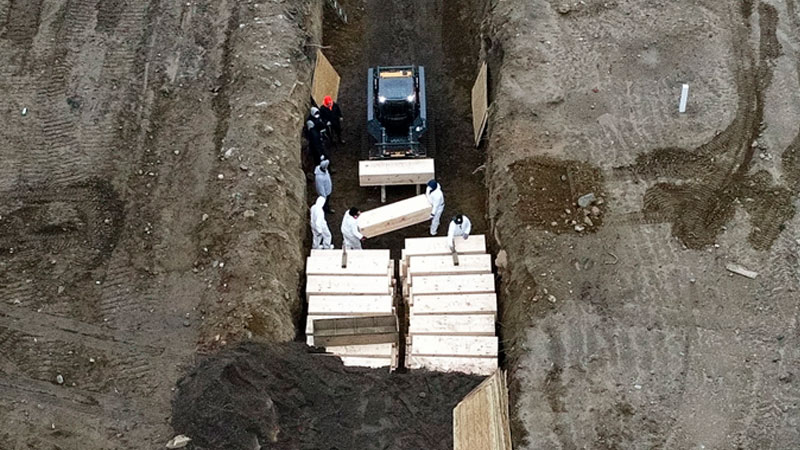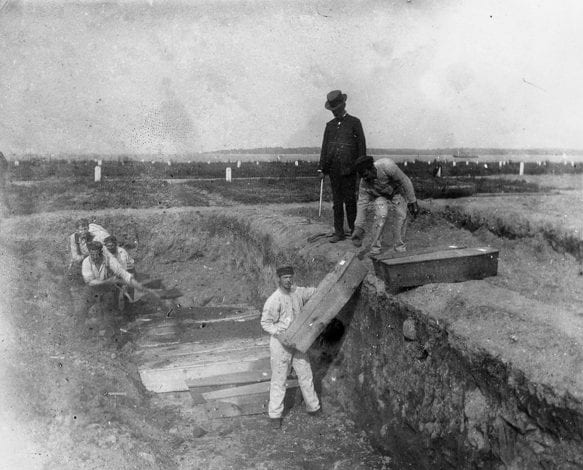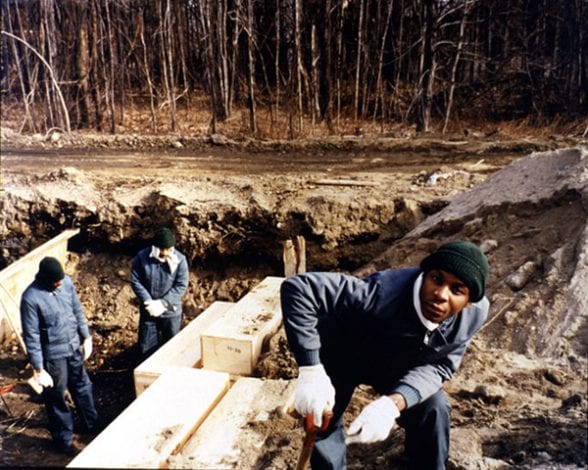
With its curious and often dark history, New York City’s Hart Island is no stranger to notoriety. Now it is once again in the news. Over the past few weeks, Hart Island has become home to the City’s unclaimed COVID-19 causalities.
Until deaths from the pandemic started to mount, burials at Hart Island were slow but steady, perhaps a dozen a week. The homeless, indigent, and the unclaimed were laid to rest by prisoners from nearby Riker’s Island. But now, more than two dozen souls a day is the norm. These are the unclaimed fatalities of New York’s COVID-19 epidemic. The plain caskets aren’t handled by prisoners. Instead, contractors decked out in full personal protection wear stack the caskets in mass graves.
It is not yet clear if the bodies currently being interred at Hart Island will stay there or if the Island is just a temporary stopover for those who succumbed to the virus.
Hart Island has always been a somewhat mysterious place. With over a million bodies buried there, it’s no wonder. Its history goes back to the 1600s, but the first burials took place during the Civil War. At various times it’s been home to a POW camp, a missile base, a quarantine camp, a reform school, and a prison. We wrote a profile of the island back in 2015 and have included the original story for you below.
HART ISLAND: GROUPS TRY TO PULL IT OUT OF THE SHADOWS.
By: | Date: Thu, February 19th, 2015
You may not have heard of Hart Island, New York City’s potter’s field. The cemetery covers more than a hundred acres and is said to be home to more than a million people whose bodies were left to the city to bury. Even if you are a New Yorker, it’s not likely that you’ve been to the island since access is extremely difficult to get and regulations once you get there are strict.

Jacob Riis Collection © Museum of the City of New York. From the Hart Island Project Website.
Hart Island was part of New York City even before Brooklyn, Queens, the Bronx or Staten Island. The island was purchased in 1868 by the Department of Charities and Correction for the purpose of setting up a workhouse for older boys from the House of Refuge on Randall’s Island.
Soon after the workhouse opened in 1869, burials of unclaimed and unidentified people began on Hart Island. Inmates from Blackwell’s Island Penitentiary traveled by ferry accompanied by bodies released for burial from the city morgue at Bellevue Hospital. Riker’s Island inmates accompanied by a morgue truck still travel by ferry on weekday mornings to Hart Island.
Mass burials on Hart Island began in 1875. A numbered grid system was implemented to facilitate disinterments for later identification at the morgue. Today, most of the buried are identified. The workhouses are long closed. Yet, the system of burials remains unchanged and graves inaccessible.
Despite the fact that the Hart Island cemetery belongs to the public, not just anyone can visit there. The Department of Corrections controls the site, and travel to the island must be approved and scheduled far in advance. The DOC transports a small number of people once each month. While there, visitors must remain near a small gazebo that is not among the graves. In fact, no one is permitted to go anywhere near the gravesites. Photographs are off-limits, and even cell phones are restricted. Journalists have been permitted to visit the island from time to time, but it is certainly not encouraged.
About Hart Island
- Hart Island is the largest tax-funded cemetery in the world.
- The island was purchased by the City of New York in 1868 for $75,000.
- Mass burials began in 1875.
- There is only one individual gravesite on the island, the first baby in NYC to die from AIDS.
- In 1865, the island was used as a POW camp for nearly 3,500 Confederate soldiers.
- The island was used as a Nike Ajax missile base during the Cold War.
- During WWII, the US Navy used Hart Island as a disciplinary center.
- During the 60s and 70s, Hart Island was used as a narcotics rehab center.
- Prison operations on the island were discontinued in 1982.
- Hart Island is still used for 2,000 burials each year. Many of these are infants and stillborn babies.
- The Island has been used as a film and TV location on a number of occasions. Most notable are an appearance in Law & Order Criminal Intent, The Saint of Fort Washington, and Don’t Say a Word.
- A comic book series, Potter’s Field by Mark Waid, revolves around an anonymous investigation into who is buried at Hart Island.
- The Island appears in a number of literary works, including William Styron’s Lie Down in Darkness and Mark Helprin’s Winter’s Tale.
- Bobby Driscoll, the voice of Peter Pan and star of Disney’s Song of the South and Treasure Island, is buried there.
- Other notables buried on the island are playwright, screenwriter and director Leo Birinski and novelist Dawn Powell.

Inmates pause during a burial ©1992 Joel Sternfeld From: The Hart Island Project website.
Authorities are taking steps to improve access to Hart Island and lift the shroud of secrecy that surrounds it. In December 2014, the New York Civil Liberties Union filed a federal class-action lawsuit aimed at giving family members access to gravesites. The suit is still pending. In March of last year, the New York City Council introduced legislation to create a public park on the site, and there is a grassroots effort to transfer control of the island from the DOC to the jurisdiction of the Parks Department.
It was not until 2013 that the DOC provided access to information on who is buried on the island. With the exception of a few years that are missing due to a fire on the island, there are records dating back to 1881. The DOC now provides a searchable database with information dating back to 1977. Another database, maintained by a group known as The Hart Island Project, also provides data on individuals dating back to 1980. The group’s website, The Travelling Cloud Museum, also offers an interactive map that allows you to search the graveyard by plot. The Project continues to add to its data and works with individuals to help them locate family members who are interred on the island.
Read more about Hart Island
- Visiting the Island of the Dead
- What Happens When a Homeless New Yorker Dies
- The Isolated Island Where New York’s Unknown and Unclaimed Are Buried









